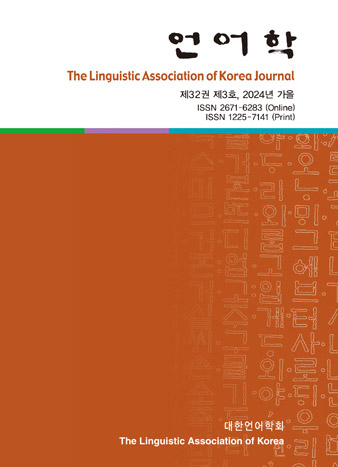대한언어학회 전자저널

-
Machine Translation of Idiomatic Expressions and Slang Based on Korean Drama
-
In Support of the Non-Derivational Analysis of Korean Ditransitive Constructions
-
ChatGPT-integrated English Writing: Writing Strategies and Perceptions
-
On the Differences between American and British English Bible Versions with Reference to get Passive
32권 3호 (2024년 9월)
- On the Differences between American and British English Bible Versions with Reference to get Passive
-
Sungkyun Shin
Pages : 105-119
Abstract
Keywords
# functional # cyclicity # diachronic study # get passive
References
- Bosworth, J. (1907). The Gospels. Gothic, Anglo-Saxon, Wycliffe and Tyndale Versions. London: Gibbings and Company.
- Chomsky, N. (2012). Minimal recursion: Exploring the prospects. In T. Roeper and M. Speas. Recursion (Proceedings of the UMass conference on recursion). Oxford: Oxford University Press.
- Chomsky, N. (2013). Problems of projection. Lingua. 130, 33-49.
- Chomsky, N. (2015). Problems of projection: Extensions. In: Structures, Strategies, and Beyond, ed. Elisa Di Domenico et al, 3-16. Amsterdam: John Benjamins.
- Chomsky, N. (2020). The UCLA Lectures. https://ling.auf.net/lingbuzz/005485.
- Chomsky, N. (2021). Minimalism: Where are we now, and where can we hope to go. Gengo Kenkyu, 160, 1-41.
- Chomsky, N. (2022). Genuine explanation and the strong minimalist thesis. Cognitive Semantics 8, 347-365.
- Chomsky, N. (2023). Noam Chomsky: The false promise of ChatGPT. The New York Times, March 8, 2023.
- Chomsky, N., Belletti, A., & Rizzi, L. (2002). On Nature and language. Cambridge: Cambridge University Press.
- Chomsky, N., Gallego, Á. J., & Ott, D. (2019). Generative grammar and the faculty of language: Insights, questions, and challenges. CJL.lingbuzz/003507.
- Chomsky, N., Seely, T. D., Berwick, R. C., Fong, S., Huybregts, M. A. C., Kitahara, H., McInnerney, A., & Sugimoto, Y. (2023). Merge and the strong minimalist thesis. Published online by Cambridge University Press.
- Denison, D. (1993). English historical syntax: Verbal constructions. New York: Longman.
- Gabelentz, G. von der (2016)[1891; 1901]. Die Sprachwissenschaft: ihre Aufgaben, Methoden und bisherigen Ergebnisse. Herausgegeben von Manfred Ringmacher and James McElvenny. Berlin: Language Science Press. http://langsci-press.org/catalog/book/97
- Gelderen, E. van. (2022). Third factors in language variation and change. Cambridge; New York, NY: Cambridge University Press.
- Gelderen, E. van. (2024). The linguistic cycle: Economy and renewal in historical linguistics. New York and London: Routledge.
- Grammar-Quizzes. https://www.grammar-quizzes.com.
- Granger, S. (1983). The 'be + past participle' construction in spoken English: with Special emphasis on the passive. (North-Holland Linguistics Series, 49.). Amsterdam/New York/Oxford: North-Holland.
- Jespersen, O. (1909-49). A modern English grammar on historical principles, 7 vols.(Repr. London, 1961.) Heidelberg/Ejnar Munksgaard, Copenhagen: Carl WintersUniversitattsbuchhandlung,
- Mair, C., and G. Leech. (2006). Current change in English syntax. The handbook of English linguistics. ed. Bas Aarts and A. MacMahon. Oxford: Blackwell, 318-342
- Mitchell, B., & Robinson, F. C. (1992). A guide to Old English. Fifth Edition. Oxford UK & Cambridge USA: Blackwell.
- New English Bible. (1970). Oxford and Cambridge: Oxford University Press and Cambridge University Press.
- New American Standard Bible. (1995) and (2020). The Lockman Foundation
- Petré, P., & Cuyckens, H. (2009). Constructional change in Old English and Middle English copular constructions and its impact on the lexicon. Folia Linguistica Historica, 30(2009), 311-366.
- Revised English Bible. (1989). Oxford and Cambridge: Oxford University Press and Cambridge University Press.
- Shin, S. (2017). A diachronic study of the English get passive. The Jungang Journal of English Language and Literature, 59(2), 239-259.
- Swan, M. (2005). Practical English usage. Oxford: Oxford University Press.
- The American Bible Society. (1976). The good news translation. Philadelphia, PA: GNTD.
- The Committee on Bible Translation. (1978). New international version (Revised 1983). Traugott, E. C. (1972). A history of English syntax: A transformational approach to the history of English sentence structure. New York: Holt, Rinehart, and Winston.
- Visser, F. Th. (1963-73). An historical syntax of the English language, 4 Volumes Leiden: E. J. Brill.